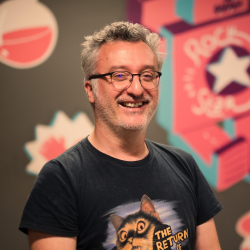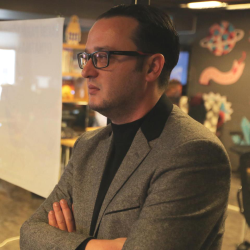Tutorials
From A Community Center to a Game Education Sandbox
Description
Like every design field, game design education is also a black hole. With the hyperjumps in technology and changing player profiles, it is becoming more and more ambiguous and ambitious. However, different from the other design fields, game design has a community advantage which has its roots in gaming and demoscene subcultures. Following those roots, 'indie' game developer scene was established and it continues to stay alive still with the community activities and support in İstanbul. Both the components of those activities and processes of a casual game design inspired BUG to come up with a game plan for an academic curriculum and a sandbox environment.
Curriculum Vitae
Dr. Güven Çatak started to write in video games magazines (PC Gamer Turkey, Level and Oyungezer) and make short films while studying architecture at İstanbul Technical University. His shorts won several awards and were screened at various festivals. After his media adventure, he continued his games career as an academic in Bahcesehir University. He has a master thesis on “Usage of Architecture in Video Games” and a PhD thesis on “Using Video Games in Design Education: Basic Design Playground”. His media network and academic studies empowered him to found “BUG Lab” which kickstarted indie game scene in İstanbul and eventually transformed into an education platform including undergraduate and master programs on game design with a state funded incubation centre (TEKMER) and a virtual reality space. He is still working as an associate professor in Bahcesehir University and running BUG Lab and its components.
Dungeons and Dragons in the Classroom: Teaching Narrative Design
Description
Storytelling courses in game design departments are usually rooted in the literature and cinema studies that analyze stories in passive mediums. The interactive nature of digital games necessitates different methodologies and resources to analyze stories where the user is not merely a passive observer but an active participant as the player. This tutorial shares insights about integrating the Dungeons and Dragons rules, novels, characters, and settings into a “Basics of Storytelling” undergraduate course in a Digital Game Design Department. The analytic-interpretive approach employed in this tutorial could provide a means to enrich existing theories in game design education.
Curriculum Vitae
Barbaros Bostan is a Professor in the Digital Game Design department at the Bahcesehir University/Turkey. His research areas include computer games, presence, interactivity, gamer psychology, player motivations and player profiling. Bostan has teaching experience in the areas of game history and analysis, storytelling in games, player psychology, research methods and interactive narrative. He reviews journal articles and book chapters for various journals and publishers, local and international. He was the editor of Gamer Psychology and Behavior, Game User Experience and Player-Centered Design and Games and Narrative: Theory and Practice books published by Springer. He was also one of the section editors of Encyclopedia of Computer Graphics and Games published by Springer.







